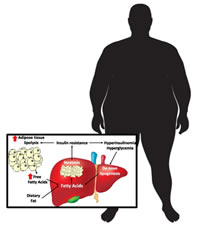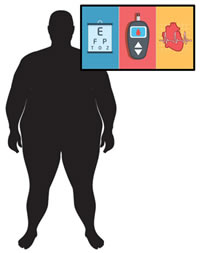
Focus Area 1

Running low on energy triggers the body to release gluconeogenic hormones, epinephrine and glucagon, to initiate release of TAG from adipose tissue for ATP production.
Image adapted from News Medical
Focus Area 2

Expression of enzymes that breakdown TAG in the adipocyte, such as Hormone Sensitive Lipase (HSL), are essential for production of free fatty acids (FFA) and glycerol. FFA are bound to proteins such as albumin for transport through the blood to peripheral tissues.
Focus Area 3

Once the FFA in the blood reach peripheral tissues, such as the muscle, they need to be moved into the mitochondria by transporters since they are too large to move by diffusion. Carnitine palmitoyltransferaes 1 (CPT1) is an enzyme that allows for the movement of FFA out of the cytosol and into the mitochondrial membrane. In the mitochondria, Acetyl-CoA molecules are produced by the "breaking" of the long carbon chain FFA molecule at the β-carbon. ATP is made from the newly released Acetyl-CoA molecule.
Focus Area 4

Obesity causes an insensitivity to insulin release. Insulin signals to the body that lipolysis needs to turn off so that glycolysis and proper storage of energy can occur. However, without insulin sensitivity, lipolysis is never fully "turned off" and FFA are continuously released into the bloodstream. This continues a cycle of more insulin being released when food is eaten, resistance to the signal which allows lipolysis to continue, and an abundance of glucose and FFA in the blood.
Image provided by The American Diabetes Assoc.
Focus Area 5

Insulin resistance is a cause of Type II diabetes. Type II diabetes is described as being hyperglycemic or having too much glucose/energy in the blood. Therefore, it is very common in patients who are afflicted with obesity.
Image provided by Everyday Health